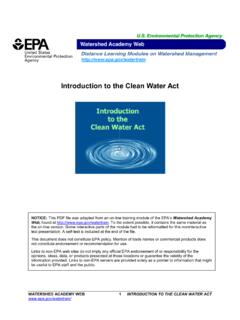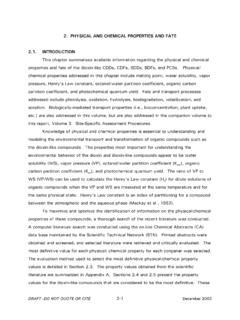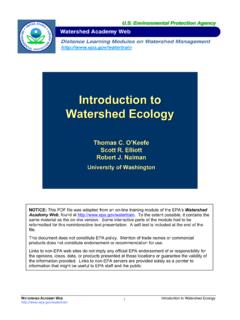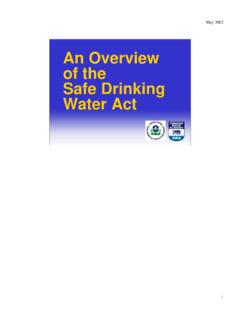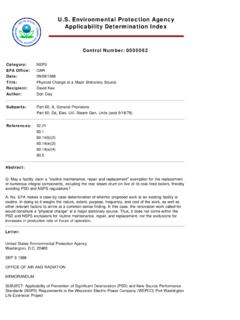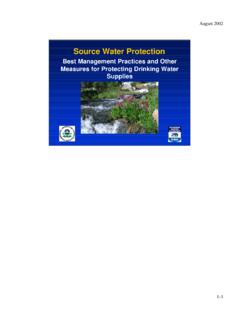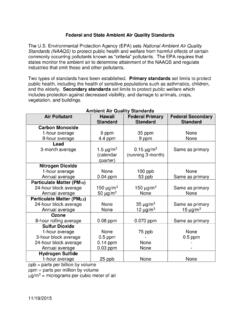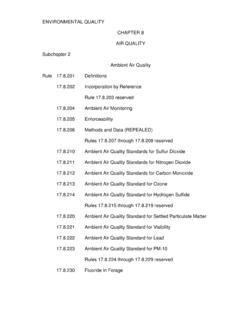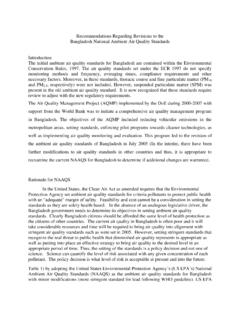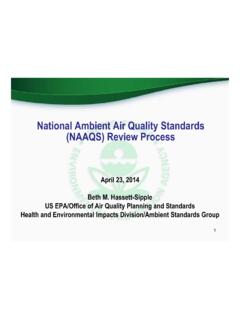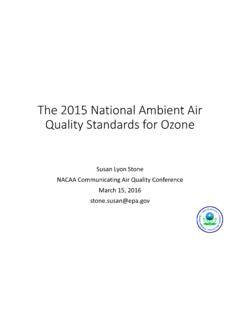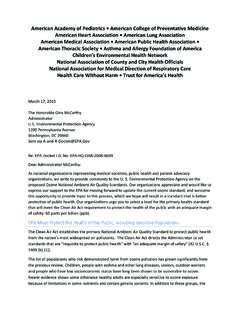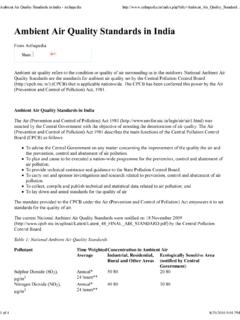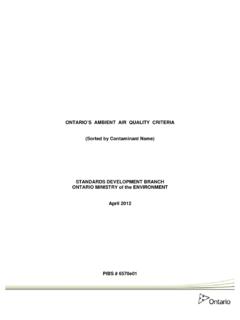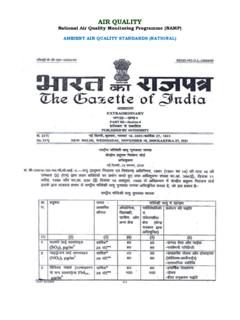Transcription of Ambient Concentrations of Benzene
1 1 Ambient Concentrations of Benzene Exhibits 2 Introduction Benzene is an air toxic emitted from gasoline service stations, motor vehicle exhaust and fuel evaporation, the burning of coal and oil, and various other sources. In addition to being a common air pollutant, Benzene may also contaminate water. Urban areas generally have higher Ambient air Concentrations of Benzene than other areas. People exposed to Benzene at sufficient Concentrations may experience various health effects, including cancer and damage to the immune system, as well as neurological, reproductive ( , reduced fertility), developmental, respiratory, and other health problems. Plants and animals may also be harmed by exposures to Benzene ( EPA, 2003). Benzene is one of the most widely monitored air toxics. Data from the National Air Toxics Trends Sites network is expected to provide trends information for other air toxics in the next Report on the Environment.
2 This indicator reflects Ambient Concentrations in micrograms per cubic meter ( g/m3) of Benzene from 1994 to 2009, based on the annual average. This indicator displays trends averaged over 22 urban monitoring sites that have consistent data for the period of record from Photochemical Assessment Monitoring Stations, Urban Air Toxics Monitoring Stations, and Non-Methane Organic Compound Monitoring Stations. What The Data Show Average Benzene Concentrations declined 66 percent from 1994 to 2009 (Exhibit 2-43). Also shown in Exhibit 2-43 are the 90th and 10th percentiles based on the distributions of annual average Concentrations at the 22 monitoring sites. These data provide additional graphical representation of the distribution of measured Concentrations across the monitoring sites for a given year: the shaded area in the exhibit displays the concentration range where 80 percent of measured values occurred for each year.
3 Limitations In order to provide trend data for 1994-2009, only 22 monitoring sites met this indicator s site selection criteria, and these sites were primarily located in urban areas. Because of the limited number of sites that are primarily located in urban areas, Exhibit 2-43 does not necessarily represent an overall national trend in Benzene Concentrations . Benzene , while an important air toxic, is only one of many toxics typically found in outdoor air. Data Sources Summary data in this indicator were provided by EPA s Office of air quality Planning and standards , based on Benzene Ambient air monitoring data in EPA s air quality System ( EPA, 2010) ( ). National trends in this indicator are based on the subset of Benzene monitoring stations that have sufficient data to assess trends since 1994. References EPA (United States Environmental Protection Agency). 2010. Data from the air quality System.
4 Accessed 2010. 3 EPA. 2003. National air quality and emissions trends report 2003 special studies edition. EPA/454/R-03/005. Research Triangle Park, NC. Metadata (Technical Documentation) Identification 1. Indicator Title Ambient Concentrations of Benzene 2. ROE Question(s) This Indicator Helps to Answer This indicator is used to help answer one ROE question: "What are the trends in outdoor air quality and their effects on human health and the environment?" 3. Indicator Abstract This indicator presents trends in Ambient Concentrations of Benzene for 22 locations across the from 1994 to 2009. Benzene is a hazardous air pollutant that may cause cancer as well as damage to reproductive, immune, and neurologic systems in exposed populations. 4. Revision History May 2008 - Original indicator posted December 2008 - Indicator updated December 2009 - Indicator updated March 2010 - Metadata updated Data Sources 5.
5 Data Sources Data used for this indicator came from three EPA monitoring programs: (1) the Photochemical Assessment Monitoring Stations (PAMS) Program, (2) the Urban Air Toxics Monitoring Program (UATMP), and (3) the Non-Methane Organic Compound (NMOC) Monitoring Program. In addition, these data from national monitoring programs were supplemented by information collected by individual state efforts. These monitoring networks conform to uniform criteria for monitor siting, instrumentation, and quality assurance. 6. Data Availability The complete set of Benzene monitoring data used to prepare this indicator can be queried from the publicly available air quality System (AQS) database. Summary data in this indicator were provided by EPA s Office of air quality Planning and standards , based on queries run on the raw Benzene Ambient air monitoring data in AQS ( ). Data also are available through 4 Information about AirData and AQS can be found at and Methodology 7.
6 Data Collection Survey Design This indicator is based on 1994-2009 Ambient air quality data retrieved from EPA s air quality System (AQS) in 2010. AQS data are direct measurements of pollutant Concentrations at monitoring stations operated by tribes and state and local governments throughout the nation. EPA and other federal agencies also operate some air quality monitoring sites. For more information about the AQS, see This indicator reflects only those sites that met specific criteria for data completeness over the period of record (1994-2009). In all, 22 sites met the criteria for this analysis. Spatially, these sites are distributed across the nation, although they tend to be more heavily representative of larger urban areas, where monitoring is generally more extensive. The data used to derive this indicator represent the best, most readily available data on Ambient air toxics Concentrations . Benzene is one of the most widely monitored air toxics, and thus trends in Benzene serve as a useful indicator of the state of the environment.
7 The data for this indicator are collected under three national programs of Ambient air quality surveillance, each with its own specialized focus. The UATMP characterizes the magnitude and composition of potentially toxic air pollution in, or near, urban locations. The NMOC Monitoring Program also focuses principally on urban areas, while the PAMS Program focuses on areas with significant ozone non-attainment problems ( Benzene and other volatile organic compounds [VOCs] are precursors to ground-level ozone). This indicator is based on data from 22 monitoring locations that met specific criteria for temporal coverage. Although year-to-year trends can be influenced by meteorological conditions, annual averages can be expected to diminish the influence of meteorological variability. This record is sufficiently long (16 years) such that it can provide a good indication of general trends over time. Spatially, these monitors are distributed across the , though mostly in urban areas.
8 This spatial distribution yields useful information because (1) a large percentage of the population lives in urban/suburban areas, and (2) these areas are where sources of Benzene ( , vehicles, gasoline stations) tend to be most concentrated. In general, air toxics monitoring efforts focus on providing data for assessing public health consequences of air pollutants, and therefore, the monitors tend to be concentrated in urban areas with modest coverage in most rural areas. The Ambient monitoring network is not designed to represent specific areas, specific sensitive populations, or ecosystems. Sampling Procedures Ambient Concentrations of Benzene are measured using a set of standard sampling and analytical methods. Typically, these methods are designed to determine Ambient air Concentrations over a 24-hour period. These methods are documented in EPA s Compendium of Methods for the Determination of Toxic Organic Compounds in Ambient Air (see ).
9 These Compendium Methods have 5 undergone extensive independent peer review and, when applied correctly, are widely viewed as providing scientifically valid measurements. Other information about Ambient air monitoring can be found at Documentation Standard documentation is available to support these data. The Ambient Monitoring Technology Information Center (AMTIC) provides links to numerous resources that describe sampling and analytical methods for air toxics (see: ), including the Compendium of Methods for the Determination of Toxic Organic Compounds in Ambient Air, EPA-625/R-96-010b ( ). A description of the UATMP sampling design and monitoring plan is in the 2003 UATMP Final Report (July 2004; ).The monitoring objectives for the PAMS network are found in 40 CFR 58, Appendix D 40 CFR 58 Subpart E. The monitoring objectives for the NMOC Monitoring Program are found in several EPA documents (EPA-454/4-92-010; EPA-454/4-91-008; EPA-454/4-90-011).
10 The monitoring networks and other aspects of survey design are documented in UATMP (2004) and PAMS monitoring objectives: 40 CFR 58, Appendix D; 40 CFR 58 Subpart E (both available at ). Additional general information about PAMS is available at UATMP and NMOC monitoring objectives are documented at (for NMOC, see EPA-454/4-92-010; EPA-454/4-91-008; and EPA-454/4-90-011). EPA s National Air Monitoring Strategy is documented at Analytical methods used to collect the Benzene concentration data for this indicator are documented in the references listed above for the individual monitoring programs. Generally, most sampling followed peer-reviewed methods documented in EPA s Compendium of Methods for the Determination of Toxic Organic Compounds in Ambient Air (see: ). 8. Indicator Derivation The conceptual model used to derive this indicator has been used and thoroughly reviewed as part of the Agency s national report on air quality trends.
